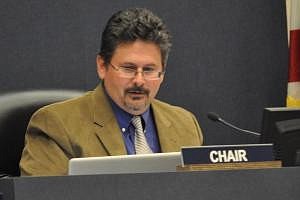- April 26, 2024
-
-
Loading

Loading

Not only is the overstaffed paraprofessional program in Flagler County schools costing too much money, but it also may be hurting students, according to Tracy Umpenhour, director of Exceptional Student Education for Flagler County Schools.
“Part of the concern we have when paraprofessionals are with students is the overreliance that students gain from having a paraprofessional for too long,” Umpenhour said. “We even find that sometimes, students wait for a prompt from a paraprofessional instead of doing things on their own.”
Umpenhour said at a Tuesday emergency workshop meeting of the Flagler County School Board that up to 27 paraprofessional positions can be cut from the schools.
During that meeting, the board finalized a list of $1.8 million in cuts the district can make for next year if a 0.5 mill tax does not pass at special election next month. The list was generated at a May 9 budget workshop, and was verified by the board Tuesday.
The list came after a week of grim discussions about the district’s budget, which included brief considerations of closing schools or cutting art and technology classes. Six paraprofessional positions were included in the final list. The board has discussed eliminating more positions over the next three years.
The school district employs 98 paraprofessionals, although standards set by the state recommend just 56. The positions allocated by the state’s standard are paid by state funding; the costs for additional paraprofessionals are swallowed by the district. Umpenhour recommended dropping the number of paraprofessionals to about 70 for the 2013-2014 school year and continuing the cuts over the next several years.
Paraprofessionals working in Flagler’s schools earn about $18,000 annually.
“I don’t take this lightly,” Umpenhour told the School Board, referring to her recommendation of further purging paraprofessional positions. “I get it, this is not easy, but we have to base it on what the allocated need is.”
School Board member Sue Dickinson, who fought against eliminating the first six paraprofessional positions, said the state’s allocation standards were off. She said she has been in classrooms and watched teachers who are spread thin try to give adequate attention to their ESE students and the rest of their classrooms.
But Tuesday, she said her fight was over.
“I surrender; I lost the battle,” Dickinson said. “I tried to save the jobs, but I lost them.”
Umpenhour was just one of the district’s department heads who addressed the School Board on Tuesday. Heads of all district departments out of the Government Services Building stood before the board at its workshop to justify the size of their staffs.
Other department heads reported years of tightening of their departments. Many said they were already stretched as thinly as possible.
Tuesday’s meeting concluded a series of budget workshops, held so the board could identify potential cuts they could make in case a proposed 0.5 mill tax levy does not pass in a special election next month.
At the first of these meetings, School Board members said they had been constraining their budgets for years and could not find anywhere else to cut.
However, the conversation turned into what board member Colleen Conklin described as a “healthy look” at the district’s budget, opening it to scrutiny it might have otherwise avoided.
Board members continued to suggest further cuts as the day ended, including a decision to suspend its membership in state and national associations and a superintendent’s association for next year (about a $17,000 savings).
Dickinson criticized a legislative decision that requires individual districts to pay college tuition for dual-enrollment students, saying that it was the district’s responsibility to pay for K-12 education, not any classes beyond that point. She asked that district staff look into what penalties the district would face if it refused to comply.
Board chair Andy Dance asked that the board ask a committee to further scrutinize its internal operations as budget discussions continue.
“We haven’t done a really good job of obtaining stakeholder input,” Dance said, adding that doing so is considered a best practice for school boards. “I’d like to bring back the business advisory committee to look at our organizational structure. Good or bad, we’ll have more people out there in the public with intimate knowledge of our organizational structure.”